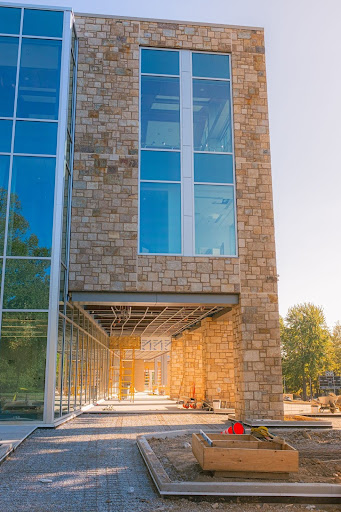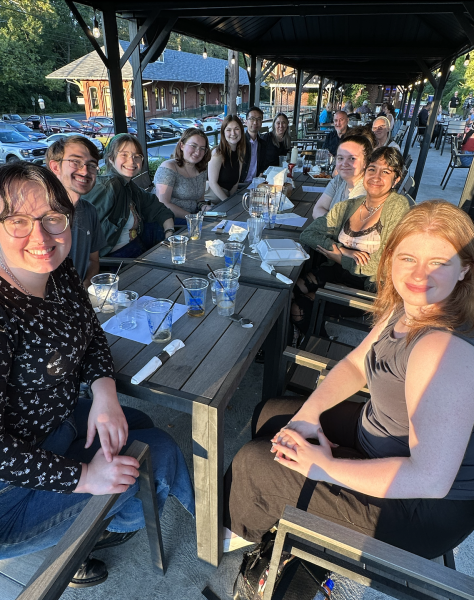Accessibility: Still an Issue on Moravian Campus
Moravian University student Loriana Andes had to use a scooter on campus at the beginning of the 2022 spring semester because of ankle surgery, but getting to class sometimes proved problematic.
“The buttons to open the [automated] doors didn’t work, even in the Haupert Union Building (HUB),” said Andes. “So I would always have to have someone hold the door for me.”
The uneven and cracked sidewalks also were hard to navigate.
“One day on my scooter, it literally caught the sidewalk, and I fell off the scooter,” she said.
Andes found that accessibility can be an issue on Moravian University’s campus.
Uneven sidewalks, narrow doorways, heavy doors, and malfunctioning elevators are all potential accessibility issues on campus, some students say. However, the university is trying to improve accessibility on campus, said Moravian student and founder and president of Disability and Neurodiversity Advocacy (DNA) Shayla Borger.
Some of these issues are harder to address than others because Moravian, which was founded in 1742, has several older buildings. These include Comenius and Zinzendorf halls, which were built in 1891 and 1892, said Borger.
“A lot of rooms have really narrow doorways,” said Borger. “So even if [a room] is on the first floor, or there’s an elevator to that floor, [students, faculty and staff who are disabled] still can’t get into the room. [Their] chair doesn’t fit through.”
Another accessibility issue is the weight of some of the doors.
Moravian tried to solve this problem by installing automated doors, said Borger.
However, some students, like Andes, report that the push-buttons to activate the doors do not always work.
Moravian also installed elevators in the newer buildings on campus. Yet, sometimes these and other accommodations do not work as they should.
Moravian University student and Hurd Integrated Living and Learning (HILL) Resident Advisor Michael Irving, who had a hip reconstruction surgery and was on crutches during the fall 2022 school semester, experienced complications with the elevators in the HILL.
“There have been some problems where you couldn’t necessarily use the elevator from a certain floor,” said Irving. “So I would have to take the stairs up to get to the floor right above it or below it.”
While Andes had an issue with the uneven sidewalks, Borger said that with the new HUB renovation, it does not make sense to tear up the sidewalks right now to fix them if they have to pave them again after the renovation.
Although not perfect, Moravian University does try to keep up with its sidewalks and make them as accessible as possible, said Borger.
“Sometimes they sand [the sidewalks] down . . . so it’s almost like a ramp or they fill it with sand,” said Borger. “But it’s not kept up on as much as it could be.”
The crosswalks are also not always accessible to a disabled individual, either, said Borger.
For example, outside of the HUB, “There is a crosswalk but no curb cut,” she said, pointing out that a disabled person in a wheelchair or on a scooter would have to go further down and cross where there is a curb cut but no crosswalk.
There is also a problem with how a student who is disabled might get from North campus to South campus on the shuttle. It is already hard for them to get around, and doing so in 20 minutes between classes might be challenging, said Irving. “Sometimes getting on the shuttle is a little rough, especially if it is packed,” said Irving. “So I would say that one area to address would be [the shuttle].”
One of Moravian’s solutions to this issue is to have campus police transport students from one campus to another, said Irving.
When Irving first came back to Moravian University after his surgery, he used campus police to travel between North and South campus, he said.
DNA has an event planned for the spring 2023 semester where individuals will travel throughout Moravian University’s North campus to identify and discuss different accessibility issues. They are thinking about calling it “A Movement Towards Accessibility,” said Borger.
This event is meant to address the accessibility issues found on Moravian University’s campus as well as other locations.
“We’re going to use physical barriers more as a symbol of larger issues,” said Borger.
There is a possibility that DNA will turn this event into a fundraiser to help pay for supplies to help with accessibility issues.
Moravian University has taken steps to improve accessibility on campus.
Yasmin Bugaighis, director of Facilities Management, Planning & Construction, said the office oversees the physical campus services, which include custodial, grounds, events setup, maintenance, utilities (gas, electric, oil, water & sewer) and shuttle.
“Accessibility is always part of the decision-making process,” she said.
Facilities Management works with the Accessibility Services Center (ASC) to ensure that the campus is more accessible.
“This does not by any means mean that all spaces and buildings on campus are fully accessible. We know that is not true,” said Bugaighis. “However, working with other offices on campus, we make sure that there are no unique programs, classes, [or] experiences that are on an inaccessible route or part of campus.”
Facilities Management was recently notified that the music recording studio, located on South Campus in the HILL, is located on an inaccessible route. The university is currently working on moving the studio to a more accessible spot, said Bugaighis.
Facilities Management is currently working on the HUB renovation and expansion project.
“The HUB renovation/expansion project will be accessible,” said Bugaighis.
According to the Accessibility Services Center (ASC), “The ASC ensures access for every student with a disability by removing barriers in design, promoting disability as an aspect of diversity, and creating a campus where access and inclusion are seamless.”
“[The ASC works] with all students who have a documented disability to ensure they are appropriately accommodated as part of the Americans with Disabilities Act,” wrote Erica D’Agostino, who at the time was interim director of Accessibility Services.
The ASC ensures that individuals with disabilities have access to both academic and living spaces, said D’Agostino.
“The Accessibility Office is here to help,” said Irving. “They really worked with me. They tried to make sure everything was okay even [with] the difficulties that I still have on the daily. I still feel comfortable. And I feel like I’m able to manage a lot of things that I really didn’t think I’d be able to manage.”
The ASC can help with both permanent and temporary disabilities. With temporary cases, like Andes and Irving’s, they are able to contact instructors and move classes to accessible locations with ramps and elevators.
The Accessibility Office has members of the Writing Center, located on the second floor of Zinzendorf and accessible only by a steep stairway, meet with students who are disabled in Reeves Library, which is accessible, said Borger.
Students with disabilities may contact the Accessibility Office, and they will accommodate and will help contact their professors with different accommodations that they may need.
“[Inaccessibility] could impact anybody,” said Borger.
Moravian is in the process of interviewing candidates for the position of Director of Disability & Accommodation Services.









